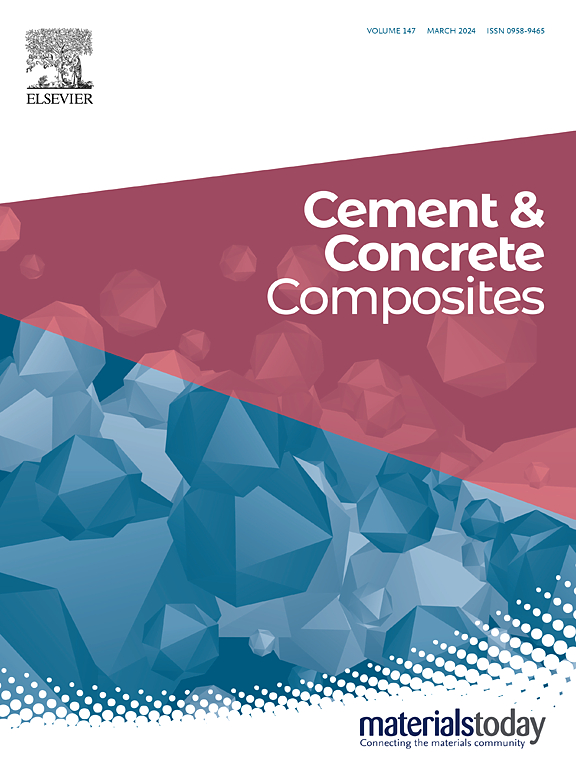超高性能微胶囊混凝土的多尺度孔隙优化:从纳米尺度到宏观尺度的收缩调节
IF 13.1
1区 工程技术
Q1 CONSTRUCTION & BUILDING TECHNOLOGY
引用次数: 0
摘要
高吸水性聚合物(SAP)被广泛应用于高性能混凝土(UHPC)的内部养护(IC)剂中,以有效缓解其自收缩。然而,SAP留下的大孔隙会对UHPC的力学性能造成重大风险。为了解决这一挑战,本研究开发了带有碱敏感外壳的双乳液微胶囊,旨在同时减少UHPC的收缩和提高机械强度。系统地研究了这些微胶囊对UHPC水化、力学性能、收缩率以及微纳米结构的影响。结果表明,微胶囊的掺入大大减少了自收缩,同时促进水化而不影响抗压强度。其中,当微胶囊含量为1.0%时,与未添加微胶囊的UHPC相比,自收缩率降低了49.5%,而抗压强度未受影响。此外,通过纳米压痕和x射线微计算机断层扫描(x射线μCT)分析,IC工艺得到了显著改善,界面过渡区(ITZ)的增强和微裂纹发展的减缓证明了这一点。提出了一种定量评价UHPC内部裂纹破碎程度的方法,系统表征微胶囊对集成电路效率的影响,为利用微胶囊技术实现低收缩率、高强度的UHPC提供理论见解。本文章由计算机程序翻译,如有差异,请以英文原文为准。
Multiscale pore optimization of UHPC with microcapsules: From nanoscale to macroscale shrinkage regulation
Superabsorbent polymers (SAP) are widely utilized as internal curing (IC) agents to effectively mitigate the autogenous shrinkage of ultra-high-performance concrete (UHPC). However, the macropores left behind by SAP can pose significant risks to the mechanical properties of UHPC. To address this challenge, this study developed double-emulsion microcapsules with an alkali-sensitive shell, designed to simultaneously achieve reduced shrinkage and enhanced mechanical strength in UHPC. The effects of these microcapsules on hydration, mechanical properties, shrinkage, and the micro- and nano-scale structure of UHPC were systematically investigated. The results revealed that the incorporation of microcapsules substantially reduced autogenous shrinkage while promoting hydration without compromising compressive strength. Specifically, at an optimal microcapsule content of 1.0 %, the autogenous shrinkage rate decreased by 49.5 % compared to UHPC without microcapsules, while the compressive strength remained unaffected. Additionally, the IC process was significantly improved, as evidenced by enhancements in the interfacial transition zone (ITZ) and the mitigation of microcrack development, validated through nanoindentation and X-ray microcomputed tomography (X-ray μCT) analyses. A quantitative method evaluating the fragmentation degree of internal cracks in UHPC is proposed to systematically characterize the impact of microcapsules on IC efficiency, providing theoretical insights into leveraging microcapsule technology to achieve UHPC with low shrinkage and high strength.
求助全文
通过发布文献求助,成功后即可免费获取论文全文。
去求助
来源期刊

Cement & concrete composites
工程技术-材料科学:复合
CiteScore
18.70
自引率
11.40%
发文量
459
审稿时长
65 days
期刊介绍:
Cement & concrete composites focuses on advancements in cement-concrete composite technology and the production, use, and performance of cement-based construction materials. It covers a wide range of materials, including fiber-reinforced composites, polymer composites, ferrocement, and those incorporating special aggregates or waste materials. Major themes include microstructure, material properties, testing, durability, mechanics, modeling, design, fabrication, and practical applications. The journal welcomes papers on structural behavior, field studies, repair and maintenance, serviceability, and sustainability. It aims to enhance understanding, provide a platform for unconventional materials, promote low-cost energy-saving materials, and bridge the gap between materials science, engineering, and construction. Special issues on emerging topics are also published to encourage collaboration between materials scientists, engineers, designers, and fabricators.
 求助内容:
求助内容: 应助结果提醒方式:
应助结果提醒方式:


